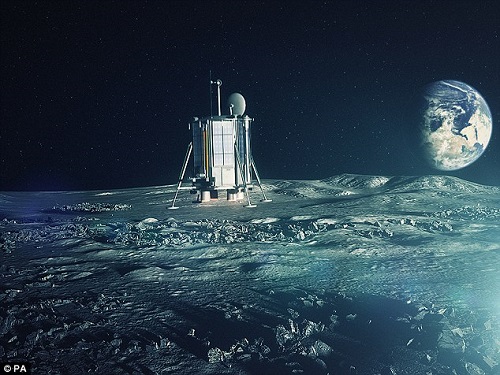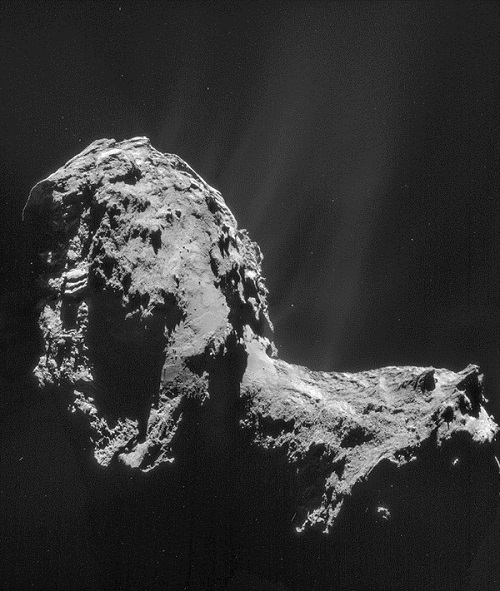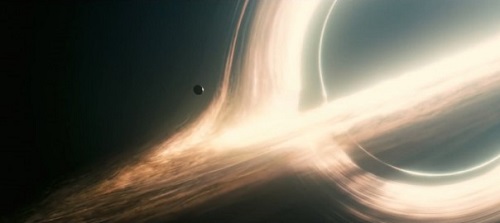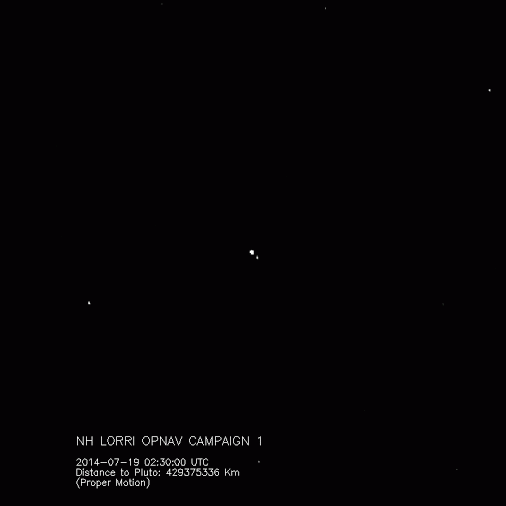Centauri Dreams
Imagining and Planning Interstellar Exploration
Of an Archive on the Moon
Lunar Mission One is an interesting private attempt to put a payload on the lunar surface, a crowdsourced project aimed at doing good science and deepening public participation in spaceflight. Remembering the Apollo days, I’m always interested in seeing what can be done to renew interest in space, and having the chance to make a contribution toward such a self-starting space mission is undeniably attractive. As witness Lunar Mission One’s pitch on Kickstarter, which has aimed for an ambitious £600,000 and has already raised £520,341.
That figure is as of this morning, with five days to go in the attempt, and it’s clear enough that £600,000 won’t buy a lunar mission of considerable complexity, as this one is. But it’s enough to take an effort that has been seven years in the building to the next level, which means establishment of working management teams and the beginning of procurement planning and risk assessment. That turns what has been a part-time volunteer project into a full-time effort.
Writing about a lunar mission is a bit out of the norm for Centauri Dreams, where I decided from the beginning to adopt a focus on the outer planets and beyond, meaning deep space technologies that could lead to an eventual interstellar effort and all that entails. But what caught my eye about Lunar Mission One is that there is a ‘deep time’ aspect to the whole thing, one that looks past short-term results to think about the future of the species and how we can connect to it. The connection grows out of Lunar Mission One’s ambitious science agenda.

Going Deep at the Pole
To explain that, let me discuss the larger plan: The Lunar Mission One probe will land at the lunar south pole. Aboard it will be a 2-meter drill connected by cable to the spacecraft, with which controllers will remotely drill a 5-centimeter borehole. The plan here is to retrieve cylindrical rock cores for analysis by instrumentation aboard the craft, and the drilling time is envisioned as lengthy — three to four months — until a target depth of 20 meters has been achieved, although the planners speculate that the drill might reach depths up to 100 meters.
This sets up some interesting science, for even the nominal 20 meter goal takes us into unexplored terrain — I believe the deepest we’ve reached from any spacecraft on the Moon is no more than a couple of meters. Enormously useful geological measurements could result and may help us better understand elements of the early Solar System’s history, including the late heavy bombardment period. Moreover, Lunar Mission One should be able to study the surrounding surface at the pole, analyzing any local materials that might aid a future human base.
But it’s what happens when the drilling is done that particularly interests me. When I spoke of ‘deep time,’ I was referring to the plan to use the borehole — after the science goals have been achieved — to lower a publicly assembled archive of life on Earth, the history of our species and a database stuffed with information about our biosphere, deep below the lunar surface. The substantial protection provided by tens of meters of lunar regolith should make this an unusually long-lasting capsule, one the planners believe can remain intact for perhaps a billion years.
Lunar Mission One also has a private archive, what it describes as millions of individual ‘memory boxes’ to which contributors to the project will be able to upload data. Longer-term funding for the mission, it is hoped, will grow out of what will become a ten-year opportunity to sell these memory boxes, which could contain photos, video, audio or any other digital information. The plan is to store tens of terabytes of such material within the private archive, with larger contributions to the project allowing the donor to buy larger amounts of storage.
To boost donations, individual memory boxes might do the trick, but my interest is in the development of the public archive, which forces decisions about how we view ourselves, what our priorities are, and what we choose to be preserved for an unknowable future generation to find. The assembly of that kind of content is a fascinating process, one that Centauri Dreams regular Heath Rezabek has devoted himself to developing through his Vessels project, which you can read about in posts like Deep Time: The Nature of Existential Risk.
The term ‘deep time’ invokes Gregory Benford’s 1999 book of that name (Deep Time: How Humanity Communicates Across Millennia), which in turn harkens back to a 1992 paper in which Benford discussed a program of freezing and preserving species in threatened ecospheres as a response to the loss of biodiversity in our era. What can we do, Benford asked, to create such a ‘Library of Life,’ and how should we assemble the samples? All this is discussed in the later book within the context of how humans communicate with each other across historical eras, questions raised by the great monuments of history, and by engineering projects like storage sites for radioactive materials that must long outlive their makers.
Lunar Mission One is exploring this terrain with its announced purpose of creating an archive that, if I read its Kickstarter page correctly, will be assembled using its core crowdsourcing methods. In my judgement, assembling a representation of our species is a highly productive exercise. Think of the Voyager Golden Record, or the ongoing private attempt to craft an archive that will be uploaded to New Horizons after its outer system mission is complete, if NASA signs off on the plan. We question our basic priorities when we look long-term, gaining perspective on the values that count, and perhaps learning where our strongest efforts need to be re-focused.
Long-haul archives, in other words, are not only about the future, but about our ability to make course corrections as we back off to view ourselves in the context of history and of nature.
So good luck to Lunar Mission One. We need projects that look at these matters. We need not only single ‘time capsule’ archives but a host of archival sites that are designed, like the Long Now Foundation’s 10,000 Year Clock, to last into a deep future against which our own lifetimes are acted out on the smallest of scales. If selling personal memory boxes is what it takes to get a serious public archive buried deep within the Moon, then let’s hope this one of many possible archives can be completed as planned, a gesture to the future from its myriad creators.

Rosetta: New Findings on Cometary Water
Where did the water in Earth’s oceans come from? It’s an open question, but new data from the Rosetta mission, in particular its ROSINA instrument (Rosetta Orbiter Spectrometer for Ion and Neutral Analysis) indicate that terrestrial water probably did not come from comets like 67P/Churyumov-Gerasimenko, around which Rosetta has been orbiting since August. There is little doubt that water reached Earth through bombardment from small bodies early in the planet’s history, but the Rosetta findings sharpen the question of where these objects came from.

Image: This composite is a mosaic comprising four individual NAVCAM images taken from 19 miles (31 kilometers) from the center of comet 67P/Churyumov-Gerasimenko on Nov. 20, 2014. The image resolution is 10 feet (3 meters) per pixel. Credit: ESA.
At work here is analysis of the ratio between hydrogen and deuterium, a heavy form of hydrogen with one proton and one neutron in the nucleus (common hydrogen lacks the neutron). This D/H ratio on 67P/Churyumov-Gerasimenko turns out to be over three times the terrestrial value, among the highest values yet measured in the Solar System, making it unlikely that comets like these supplied Earth’s oceans. Back in 1986, the European Giotto mission to comet Halley found a D/H ratio twice that of Earth’s, seeming to rule out Oort Cloud comets as the source.
67P/Churyumov-Gerasimenko and Halley are two different kinds of comet, so let’s explore this. Cometary origins are complex because of interactions in the early Solar System. Long-period comets that swing into the inner system from the distant Oort Cloud are thought to have formed originally somewhere beyond the snowline in the region where Uranus and Neptune now orbit, to be scattered by subsequent gravitational interactions with the large outer planets. 67P/Churyumov-Gerasimenko is a Jupiter-family comet, a class whose origins are believed to lie beyond Neptune in the Kuiper Belt. Comets like these sometimes have their orbits disrupted so that they fall under the gravitational influence of Jupiter, hence their designation.
In contrast to 67P/Churyumov-Gerasimenko, comet Hartley 2, which was examined by the European Space Agency’s Herschel spacecraft in 2011, turned out to have a deuterium/hydrogen ratio similar to Earth’s. The discrepancy is surprising because Hartley 2 is also a Jupiter-family comet, and models of the early Solar System produce a D/H ratio for these comets more like 67P/Churyumov-Gerasimenko, even higher than their Oort Cloud cousins.
The disparity may indicate that we know less about Jupiter-family comets and their origins than we realized. The new Rosetta data tell us that this family of comets is hardly uniform, and thus nudge us away from them and toward asteroids as the primary water delivery mechanism. Kathrin Altwegg (University of Bern) is principal investigator for the ROSINA instrument and lead author of the paper on this work, which has just appeared in Science:
“This surprising finding could indicate a diverse origin for the Jupiter-family comets – perhaps they formed over a wider range of distances in the young Solar System than we previously thought. Our finding also rules out the idea that Jupiter-family comets contain solely Earth ocean-like water, and adds weight to models that place more emphasis on asteroids as the main delivery mechanism for Earth’s oceans.”
The measurements in question were made in the first month after Rosetta’s arrival at 67P/Churyumov-Gerasimenko. With the Rosetta data, we now have D/H information about eleven comets, finding that only Hartley 2 shows a ratio matching the composition of Earth’s water. We also know that meteorites with an origin in the asteroid belt show a good fit with Earth’s D/H ratio. Although the overall water content of asteroids is lower than we find in comets, a large number of asteroid impacts could account for the primary delivery mechanism.
Meanwhile, the mission continues, and will for some time. Rosetta has now been at 67P/Churyumov-Gerasimenko for 127 days. Perihelion is 244 days away.
The paper is Altwegg et al., “67P/Churyumov-Gerasimenko, a Jupiter family comet with a high D/H ratio,” published online in Science 10 December 2014 (abstract). This ESA news release is helpful.

Why Interstellar Matters
My friend Frank Taylor was in town over the Thanksgiving holiday, having flown in from South Africa. With his wife Karen, Frank has spent the years since 2009 circumnavigating the globe aboard a 50-foot catamaran called Tahina, an adventure chronicled with spectacular photography on the Tahina Expedition blog. I highly recommend the site for anyone interested in travel and the sea, not to mention how high tech has transformed the ancient art of sailing. But when we spoke recently just before Frank returned to Africa, he had another kind of high tech in mind. Specifically, what had I thought about the film Interstellar?
I haven’t delayed my comments on the movie intentionally, but I was slow in getting to see it, missing the opportunity at the end of the Tennessee Valley Interstellar Workshop and then getting involved in recent activities including the One Earth New Horizons Message workshop at Stanford. I also wanted to read Kip Thorne’s The Science of Interstellar (Norton, 2014) and give the movie a second viewing. All that behind me, it’s time to explain why I was surprised by Interstellar. My expectations for Hollywood science fiction are always low, as I’ve found that today’s filmmaking wizardry all too often masks serious flaws in plot and character.
I can find problems in Interstellar as well, as many reviewers have, but I think this is an important movie whose mistakes aren’t significant compared to what it accomplishes. Interstellar is a movie that will baffle a large part of its audience, the movie-going public far more comfortable with battles in space and sleek starships like the Enterprise. This is not an audience that will easily follow the twists and turns through time and space that Christopher Nolan has created. But Nolan’s attention to detail, his partnership with Thorne, and his insistence on scientific plausibility wherever possible will get through to an important subset.

I’m talking about younger people with an interest in science for whom the movie’s stunning visuals will impel them to learn how to untangle the plot. For the intellectually curious, Interstellar is a tandem creation, a movie/book duality where each plays off the other — the motivated minority will want to immerse themselves in both. The film’s plot is demanding and operates at various degrees of believability, but there is a science puzzle to be untangled here, one to which Thorne’s book offers the key. When I was researching Centauri Dreams back in 2002-2004, I was surprised at how many scientists and aerospace engineers told me they had chosen their fields because of science fiction novels like Poul Anderson’s Tau Zero. This movie will have the same effect. In fact, I can think of no movie that is so likely to create careers in the sciences, particularly physics, than this one.
Let’s talk about why. Here I get into details and suppose I should say that there may be spoilers below for those who haven’t yet seen Interstellar, so proceed with caution. I could focus on various issues, from a worldwide blight to passage through a wormhole, but the film’s treatment of black holes is what I’ll use as my working material. The wormhole itself, out near Saturn’s orbit and an apparent way out for a desperate humanity, is richly described in Thorne’s chapters, especially with regard to the special effects that bring it to life.
Our protagonist, Cooper, must learn which of three planets in an unusual system dominated by an enormous black hole called Gargantua is most suited for humans. When he and his team need to get to one of these, Miller’s Planet, from their parking orbit near the black hole, they have to produce huge velocity changes in the range of 100,000 kilometers per second. Thorne goes through the physics of this, including the bizarre time distortion on a world so close to a black hole. The upshot is that a gravitational slingshot maneuver must be performed. The movie skims over the matter quickly, but Cooper does discuss how this must have been done later, when he talks about using a neutron star to decelerate. The neutron star is a bit of a fudge — it turns out it wouldn’t be big enough to force the needed maneuver, but an intermediate-mass black hole would do the trick. Thorne made this case to Nolan but the director stuck with the neutron star.
That’s a scientific error forced by Hollywood values. Thorne relates his objections to Nolan during the re-writing of the screenplay and goes on to explain what happened:
…he [Nolan] didn’t want to confuse his mass audience by having more than one black hole in the movie. One black hole, one wormhole, and also a neutron star, along with Interstellar‘s other rich science, all to be absorbed in a fast-paced two hour film; that was all Chris thought he could get away with. Recognizing that strong gravitational slingshots are needed to navigate near Gargantua, Chris included one slingshot in Cooper’s dialog, at the price of using a scientifically implausible deflector: the neutron star instead of a black hole.
Interstellar is closer to three hours than two (Thorne was writing before the film was finalized), but does anything else about this bother you? I’m going to argue that the combination of Nolan’s movie and Thorne’s book — and the fruitful collaboration the two engaged in throughout — induces the kind of puzzle-solving ethos that will prompt many a young mind to dig deeper into the movie’s physics. Nolan made a choice with a mass audience in mind, but the framework of that choice is laid bare in Thorne’s book, which goes on to explain how careful Nolan was to stick to scientific plausibility where he felt that he could. Filmmaking is always a matter of compromise, but Nolan was surprisingly tough. Finding where Interstellar works and where it stretches science out of shape is itself a lesson in problem solving.
The point is, the director was thinking about these things within a framework that, in terms of its spectacular visuals, is meticulous about getting the larger details right. Think about the accretion disk around the black hole Gargantua. Here we’re seeing a magnetic field in the process of converting gravitational energy into heat and then light — the field, explains Thorne, provides the friction that slows the circumferential motion of gas in the disk even as the black hole’s gravity tries to speed up the infalling material, with kinetic energy being converted into heat and light along the way. But go to the projections of black hole accretion disks you’ll find on the Net or in technical publications and you’ll find Nolan’s depiction is far more spectacular. Another Hollywood-enforced choice?
No. What Nolan and Thorne added was the gravitational lensing of the disk by its own black hole, an effect explored through computer code developed for the film. While you would expect that portion of the disk behind the black hole to be out of sight, gravitational lensing produces two images of it, one above and the other below Gargantua. This is special effects wizard Eugénie van Tunzelmann’s work, carefully wrought to produce the nested effect Thorne describes:
Inside these primary images, we see thin secondary images of the disk, wrapping over and under the shadow, near the shadow’s edge. And if the picture were made much larger, you would see tertiary and higher-order images, closer and closer to the shadow.

Moreover, Gargantua’s distortion of spacetime distorts the disk images, pushing the perceived disk away from the shadow on one side and toward the shadow on the other, creating an effect that appears lopsided. Here again Nolan intervened in an attempt to avoid confusion, especially as the audience tried to work out the reason for the lopsidedness of the disk and the star patterns created near its edge. So for the purposes of the imagery, he slowed the spin of Gargantua to reduce the effect, just as van Tunzelmann removed the Doppler shift created by the disk’s motion, which would have created an even more lopsided and confusing effect.
What pleases me here is that these changes and their rationale are thoroughly explored in Kip Thorne’s book, which likewise offers those intrigued with such visualizations the opportunity to explore how they could be fine-tuned and rendered with greater accuracy. Given the Hollywood culture in which he operates, I think that Christopher Nolan produced a movie with as much scientific accuracy as he could get past his producers, given the imperative for ratings and box office sales.
Most people are going to be wowed by the visuals; some will be dismayed by the all but supernatural intervention of beings from a higher dimension who may be our descendants. But a few, the ones I’m focused on, are going to use the high points of this movie — its unapologetic call for exploration, its entanglement with science as a form of quest — to choose to learn more, and there is no more engaging a guide than Kip Thorne to show them the way. Thorne says he was moved by the underlying message of Interstellar that the universe can be viewed optimistically because our species is capable of choosing its future:
But doing so, controlling our own fate, requires that a large fraction of us understand and appreciate science: How it operates. What it teaches us about the universe, the Earth, and life. What it can achieve. What its limitations are, due to inadequate knowledge or technology. How those limitations may be overcome. How we transition from speculation to educated guess to truth. How extremely rare are revolutions in which our perceived truth changes, yet how very important.
Thirty years from now there will be working scientists who explain to interviewers how Interstellar, a movie flawed by occasional mawkishness (think of Amelia Brand’s regrettable lines about love being the fifth dimension), weighed down by what may be the ultimate deus ex machina (in the form of Cooper operating through the tesseract), and reactive to Hollywood’s relentless popular ethos, nonetheless captured their imagination so that they read a book (Thorne’s) that helped to launch them down a path whose end they could not imagine. I call that a fine result, and reiterate my surprise in finding a Hollywood blockbuster I can seriously recommend.

Deep Space: Moving Toward Encounter Mode
No spacecraft has ever traveled further to reach its primary target than New Horizons, now inbound to Pluto/Charon. From 4.6 billion kilometers from Earth (four hours, 26 minutes light travel time), the spacecraft has sent confirmation that its much anticipated wake-up call from ground controllers was a success. Since December 6, New Horizons has been in active mode, a state whose significance principal investigator Alan Stern explains:
“This is a watershed event that signals the end of New Horizons crossing of a vast ocean of space to the very frontier of our solar system, and the beginning of the mission’s primary objective: the exploration of Pluto and its many moons in 2015.”

Image: Pluto and Charon, in imagery taken by New Horizons in July of 2014. Covering almost one full rotation of Charon around Pluto, the 12 images that make up the movie were taken with the spacecraft’s best telescopic camera – the Long Range Reconnaissance Imager (LORRI) – at distances ranging from about 429 million to 422 million kilometers. Credit: NASA/Johns Hopkins University Applied Physics Laboratory/Southwest Research Institute.
Not that hibernation is an unusual event for the spacecraft. We’ve followed several cycles here on Centauri Dreams, but it’s startling to realize that New Horizons has gone through eighteen hibernation periods, with two-thirds of its flight time in that state. A weekly beacon stayed alive during these periods, as did the onboard flight computer that broadcast its status tone, but much of the spacecraft was powered down to protect system components. For this special awakening, English tenor Russell Watson recorded a special version of ‘Where My Heart Will Take Me,’ which was played in New Horizons mission operations upon wake-up confirmation.
Pluto observations begin on January 15, with closest approach on July 14, and by mid-May, we will begin receiving views of Pluto and its moons that are higher in quality than anything the Hubble Space Telescope has yet given us. More on the awakening of New Horizons on this JHU/APL page. Meanwhile, the private effort to upload a message from Earth to New Horizons following the end of its science mission continues. If NASA gives the go-ahead, Jon Lomberg’s team will crowdsource content for the One Earth New Horizons Message. A workshop discussing message methods and content just concluded last week at Stanford.
The View from the Asteroid Belt
Speaking of images better than Hubble, we’ve certainly managed that with the Dawn mission, which brought us spectacular vistas from Vesta during its fourteen months in orbit around the asteroid. Now we can look forward to topping Hubble’s views of Ceres, the spacecraft’s next target. Below is an image that, while not yet better than Hubble can manage, does give us an idea of the spherical shape of the asteroid (click to enlarge). Dawn is now 1.2 million kilometers out, about three times the Earth-Moon distance from its target.
Image credit: NASA/JPL-Caltech/UCLA/MPS/DLR/IDA.
Dawn will be captured into orbit around Ceres in March, but by early 2015, we’ll be seeing images at higher resolution than Hubble has yet provided. The approach phase begins on December 26, with the nine-pixel-wide image just released serving as a final calibration of the spacecraft’s science camera. With both missions, we are pushing into unknown territory, about to see things in greater detail than our best telescopes can offer. A bit of the old Voyager and Pioneer feeling has me in its grip, a confirmation of our human need to explore and a validation of all the hard work that got us here.

At left is Ceres in the best photo we currently have, a color Hubble image. These observations were made in both visible and ultraviolet light between December 2003 and January 2004, showing brighter and darker regions that may be impact features or simply different types of surface material. 950 kilometers across, Ceres may have an interior differentiated between an inner core, an ice mantle, and a relatively thin outer crust.
Every time I see this image I remember Alfred Bester’s The Stars My Destination, a 1956 novel in which protagonist Gulliver Foyle takes the pseudonym Fourmyle of Ceres as part of the unfolding of his ingenious plan for revenge. The asteroid pops up in many science fiction tales (Larry Niven’s ‘Known Space’ stories come particularly to mind), but perhaps none as compelling as the one Dawn is about to tell us.
Young Planets, Young Stars
We’re going to be bringing both space- and ground-based assets to bear on the detection of rocky planets within the habitable zone in coming years. Cool M-class stars (red dwarfs) stand out in this regard because their habitable zones (in this case defined as where water can exist in liquid form on the surface) are relatively close to the parent star, making for increased likelihood of transits as well as a larger number of them in a given time period. Ground observatories like the Giant Magellan Telescope and the European Extremely Large Telescope should be able to perform spectroscopic studies of M-class planets as well.
So consider this: We have a high probability for planets around these stars (see Ravi Kopparapu’s How Common Are Potential Habitable Worlds in Our Galaxy?), and then factor in what Ramses Ramirez and Lisa Kaltenegger have, the fact that before they reach the main sequence, M-class stars go through a period of ‘infancy’ that can last up to 2.5 billion years. It’s an important period in the life of any planets around them because, as we saw last week in a paper by Rodrigo Luger and Rory Barnes, huge water loss can occur and there is the possibility for runaway greenhouse events that complicate a planet’s habitability.
But we need to keep digging at this issue because early M-dwarf planets are interesting targets for detection. In their new paper, Ramirez and Kaltenegger (Cornell University) point out that in the period before entering the main sequence, these stars have a luminosity much higher relative to their early main sequence values than F or G stars. In fact, an M8 star can be 180 times as bright during its contraction stage as it will be when entering the main sequence. Our G-class Sun, by contrast, was only twice as bright during this period.
What we get is a habitable zone that is located further away from the young star than we would otherwise expect, in a pre-main sequence period that, for some of the smallest stars, can last for over two billion years, meaning there is the potential for life to develop on the surface, perhaps moving below ground as the star’s luminosity gradually declines. The paper computes the luminosities of stars in classes F through M as they go through the contracting phase and onto the main sequence, with clear effects on the orbital distance of the habitable zone around the star.

Image: Changes in the position of the habitable zone over time. Credit: L. Kaltenegger, R. Ramirez/Cornell University.
The coolest of these stars, an M8 dwarf, shows an inner zone of the HZ at 0.16 AU that moves to 0.01 AU at the end of the 2.5 billion year pre-main sequence phase. In the same period, the outer edge of the HZ moves from 0.45 AU to 0.3 AU. Contrast that with our Sun, where the inner HZ edge changes from 1 AU to 0.6 AU at the end of the pre-main sequence stage after a comparatively swift 50 million years. The Sun’s outer HZ edge moves from 2.6 AU to 1.5 AU. Variations in planetary mass appear to have only a small effect on these results.
The potential for water loss on the planets of young M-class stars is enormous, much higher for this than other stellar types. Ramirez and Kaltenegger shows that planets orbiting an M8 star at distances corresponding to the inner and outer main sequence habitable zone could lose up to 3800 and 225 Earth oceans of water respectively. An M5 planet loses 350 and 15 oceans respectively, while an M1 world loses 25 and 0.5 oceans. If we look at K5 and G2-class stars, their planets at the inner and outer habitable zone lose 1.3 and 0.75 Earth oceans respectively. These figures, remember, are for planets that end up being in the habitable zone later in the star’s life, when it is firmly established on the main sequence.
Is this water loss a fatal blow to the planet’s chances for habitability? Ramirez and Kaltenegger think not, a point that is worth emphasizing. From the paper:
Our results… suggest that planets later located in the MS HZ orbiting stars cooler than ~ a K5 may lose most of their initial water endowment. However M-dwarf MS HZ planets could acquire much more water during accretion than did Earth (Hansen, 2014), or water-rich material could be brought in after accretion, through an intense late heavy bombardment (LHB) period similar to that in our own Solar System (Hartmann 2000; Gomes et al. 2005). The second mechanism requires that both the gas disk has dissipated and the runaway greenhouse stage has ended.
The situation of our own Earth is not without interest here. Ramirez commented on the issue in this Cornell news release:
“Our own planet gained additional water after this early runaway phase from a late, heavy bombardment of water-rich asteroids,” says Ramirez. “Planets at a distance corresponding to modern Earth or Venus orbiting these cool stars could be similarly replenished later on.”
We can also factor in possible planetary migration, bringing planets rich in volatiles into the habitable zone after the star has reached the main sequence. Bear in mind that the pre-main sequence period can last 195 million years for an M1 star and up to 2.42 billion for a cool M8, meaning that a planet that has lost its water through this ‘bright young star’ period could regain water and become habitable even before the star reaches the main sequence.
In terms of searching for small, rocky planets with the potential for life, then, we need to keep in mind how much farther out the habitable zone is during a young star’s pre-main sequence phase, for the larger separation between planet and star will make such planets easier to find with next-generation telescopes. This work shows that planets around stars in spectral type K5 and cooler — those that will later be located in the habitable zone during the star’s main sequence phase — can easily receive enough stellar flux to lose much or all of their water. They will need to accrete more water than Earth did or else rely on water delivered through later bombardment. They are prime candidates for remote observation and characterization.
Moreover, we learn here that planets outside the habitable zone during the star’s stay on the main sequence may once have had conditions right for life to develop, with the potential for continuing beneath the surface as the star cools. “In the search for planets like ours out there, we are certainly in for surprises,” says Kaltenegger, and it’s clear that young stars, especially M-dwarfs, offer rich targets for observation as we parse out what makes a planet habitable.
The paper is Ramirez and Kaltenegger, “The Habitable Zones of Pre-Main-Sequence Stars,” in press at Astrophysical Journal Letters (preprint).

The Interstellar Imperative
What trajectory will our civilization follow as we move beyond our first tentative steps into space? Nick Nielsen returns to Centauri Dreams with thoughts on multi-generational projects and their roots in the fundamental worldview of their time. As the inspiring monuments of the European Middle Ages attest, a civilizational imperative can express itself through the grandest of symbols. Perhaps our culture is building toward travel to the stars as the greatest expression of its own values and capabilities. Is the starship the ultimate monument of a technological civilization? In addition to continuing work in his blogs Grand Strategy: The View from Oregon and Grand Strategy Annex, Nielsen heads Project Astrolabe for Icarus Interstellar, described within the essay.
by J. N. Nielsen

If interstellar flight proves to be possible, it will be possible only in the context of what Heath Rezabek has called an Interstellar Earth: civilization developed on Earth to the degree that it is capable of launching an interstellar initiative. This is Earth, our familiar home, transformed into Earth, sub specie universalis, beginning to integrate its indigenous, terrestrial civilization into its cosmological context.
Already life on Earth is thoroughly integral with its cosmological context, in so far as astrobiology has demonstrated to us that the origins and processes of life on Earth cannot be fully understood in isolation from the Earth’s cosmic situation. The orbit, tilt, and wobble of the Earth as it circles the sun (Milankovitch cycles), the other bodies of the solar system that gravitationally interact with (and sometimes collide with) Earth, the life cycle of the sun and its changing energy output (faint young sun problem), the position of our solar system with the galactic habitable zone (GHZ), and even the solar system bobbing up and down through the galactic plane, subjecting Earth to a greater likelihood of collisions every 62 million years or so (galactic drift) – all have contributed to shaping the unique, contingent history of terrestrial life.
What other distant unknowns shape the conditions of life here on Earth? We cannot yet say, but there may be strong bounds on the earliest development of complex life in the universe, other than the age of the universe itself. For example, recent research on gamma ray bursts suggests that the universe may be periodically sterilized of complex life, as argued in the paper On the role of GRBs on life extinction in the Universe by Tsvi Piran and Raul Jimenez (and cf. my comments on this), which was also the occasion of an article in The Economist, Bolts from the blue. Intelligent life throughout the universe may not be much older than intelligent life on Earth. This argument has been made many times prior to the recent work on gamma ray bursts, and as many times confuted. A full answer must await our exploration of the universe, but we can begin by narrowing the temporal boundaries of possible intelligence and civilization.

Image: Lodovico Cardi, also known as Cigoli, drawing of Brunelleschi’s Santa Maria del Fiore, 1613.
From the perspective of natural history, there is no reason that cognitively modern human-level intelligence might not have arisen on Earth a million years earlier than it did, or even ten million years earlier than it did. On the other hand, from the same perspective there is no reason that such intelligence might not have emerged for another million years, or even another ten million years, from now. Once biology becomes sufficiently complex, and brains supervening upon a limbic system become sufficiently complex, the particular time in history at which peer intelligence emerges is indifferent on scientific time scales, though from a human perspective a million years or ten million years makes an enormous difference. [1]
Once intelligence arose, again, it is arguably indifferent in terms of natural history when civilization emerges from intelligence; but for purely contingent factors, civilization might have arisen fifty thousand years earlier or fifty thousand years later. Hominids in one form or another have been walking the Earth for about five million years (even if cognitive modernity only dates to about 60 or 70 thousand years ago), so we know that hominids are compatible with stagnation measured on geological time scales. Nevertheless, the unique, contingent history of terrestrial life eventually did, in turn, give rise to the unique, contingent history of terrestrial civilization, the product of Earth-originating intelligence.
The sheer contingency of the world makes no concessions to the human mind or the needs of the human heart. Blaise Pascal was haunted by this contingency, which seems to annihilate the human sense of time: “When I consider the short duration of my life, swallowed up in the eternity before and after, the little space which I fill and even can see, engulfed in the infinite immensity of spaces of which I am ignorant and which know me not, I am frightened and am astonished at being here rather than there; for there is no reason why here rather than there, why now rather than then.” [2]
Given the inexorable role of contingency in the origins of Earth-originating intelligence and civilization, we might observe once again that, from the perspective of the natural history of civilization, it makes little difference whether the extraterrestrialization of humanity as a spacefaring species occurs at our present stage of development, or ten thousand years from now, or a hundred thousand years from now. [3] When civilization eventually does, however, follow the example of the life that preceded it, and integrates itself into the cosmological context from which it descended, it will be subject to a whole new order of contingencies and selection pressures that will shape spacefaring civilization on an order of magnitude beyond terrestrial civilization.
The transition to spacefaring civilization is no more inevitable than the emergence of intelligence capable of producing civilization, or indeed the emergence of life itself. If it should come to pass that terrestrial civilization transcends its terrestrial origins, it will be because that civilization seizes upon an imperative informing the entire trajectory of civilization that is integral with a vision of life in the cosmos – an astrobiological vision, as it were. We cannot know the precise form such a civilizational imperative might take. In an earlier Centauri Dreams post, I discussed cosmic loneliness as a motivation to reach out to the stars. This suggests a Weltanschauung of human longing and an awareness of ourselves as being isolated in the cosmos. But if we were to receive a SETI signal next week revealing to us a galactic civilization, our motivation to reach out to the stars may well take on a different form having nothing to do with our cosmic isolation.
At the first 100YSS symposium in 2011, I spoke on “The Moral Imperative of Human Spaceflight.” I realize now I might have made a distinction between moral imperatives and civilizational imperatives: a moral imperative might or might not be recognized by a civilization, and a civilizational imperative might be moral, amoral, or immoral. What are the imperatives of a civilization? By what great projects does a civilization stand or fall, and leave its legacy? With what trajectory of history does a civilization identify itself and, through its agency, become an integral part of this history? And, specifically in regard to the extraterrestrialization of humanity and a spacefaring civilization, what kind of a civilization would not only recognize this imperative, but would center itself on and integrate itself with an interstellar imperative?
Also at the first 100YSS symposium in 2011 there was repeated discussion of multi-generational projects and the comparison of interstellar flight to the building of cathedrals. [4] In this analogy, it should be noted that cathedrals were among the chief multi-generational projects and are counted as one of the central symbols of the European middle ages, a central period of agrarian-ecclesiastical civilization. For the analogy to be accurate, the building of starships would need to be among the central symbols of an age of interstellar flight, taking place in a central period of mature industrial-technological civilization capable of producing starships.
To take a particular example, the Duomo of Florence was begun in 1296 and completed structurally in 1436—after 140 years of building. When the structure was started, there was no known way to build the planned dome. (To construct the dome in the conventional manner would have required more timber than was available at that time.) The project went forward nevertheless. This would be roughly equivalent to building the shell of a starship and holding a competition for building the propulsion system 122 years after the project started. The dome itself required 16 years to construct according to Brunelleschi’s innovative double-shelled design of interlocking brickwork, which did not require scaffolding, the design being able to hold up its own weight as it progressed. [5]
It is astonishing that our ancestors, whose lives were so much shorter than ours, were able to undertake such a grand project with confidence, but this was possible given the civilizational context of the undertaking. The central imperative for agrarian-ecclesiastical civilization was to preserve unchanged a social order believed to reflect on Earth the eternal order of the cosmos, and, to this end, to erect monuments symbolic of this eternal order and to suppress any revolutionary change that would threaten this order. (A presumptively eternal order vulnerable to temporal mutability betrays its mundane origin.) And yet, in its maturity, agrarian-ecclesiastical civilization was shaken by a series of transformative revolutions—scientific, political, and industrial—that utterly swept aside the order agrarian-ecclesiastical civilization sought to preserve at any cost. [6]
The central imperative of industrial-technological civilization is the propagation of the STEM cycle, the feedback loop of science producing technologies engineered into industries that produce better instruments for science, which then in turn further scientific discovery (which, almost as an afterthought, produces economic growth and rising standards of living). [7] One cannot help but wonder if this central imperative of industrial-technological civilization will ultimately go the way agrarian-ecclesiastical civilization, fostering the very conditions it seeks to hold in abeyance. In any case, it is likely that this imperative of industrial-technological civilization is even less understood than the elites of agrarian-ecclesiastical civilization understood the imperative to suppress change in order to retain unchanged its relation to the eternal.
It may yet come about that the building of an interstellar civilization becomes a central multi-generational project of industrial-technological civilization, as it comes into its full maturity, as a project of this magnitude and ambition would be required in order to sustain the STEM cycle over long-term historical time (what Fernand Braudel called la longue durée). We must recall that industrial-technological civilization is very young—only about two hundred years old—so that it is still far short of maturity, and the greater part of its development is still to come. Agrarian-ecclesiastical civilization was in no position to raise majestic gothic cathedrals for its first several hundred years of existence. Indeed, the early middle ages, a time of great instability, are notable for their lack of surviving architectural monuments. The Florence Duomo was not started until this civilization was several hundred years old, having attained a kind of maturity.
The STEM cycle draws its inspiration from the great scientific, technical, and engineering challenges of industrial-technological civilization. A short list of the great engineering problems of our time might include hypersonic flight, nuclear fusion, and machine consciousness. [8] The recent crash of Virgin Galactic’s SpaceShipTwo demonstrates the ongoing difficulty of mastering hypersonic atmospheric flight. We can say that we have mastered supersonic atmospheric flights, as military jets fly every day and only rarely crash, and we can dependably reach escape velocity with chemical rockets, but building a true spacecraft (both HOTOL and SSTO) requires mastering hypersonic atmospheric flight, as well as making the transition to exoatmospheric flight) and this continues to be a demanding engineering challenge.
Similarly, nuclear fusion power generation has proved to be a more difficult challenge than initially anticipated. I recently wrote in One Hundred Years of Fusion that by the time we have mastered nuclear fusion as a power source, we will have been working on fusion for a hundred years at least, making fusion power perhaps the first truly multi-generational engineering challenge of industrial-technological civilization—our very own Florentine Duomo, as it were.
With machine consciousness, if we are honest we will admit that we do not even know where to begin. AI is the more tractable problem, and the challenge that attracts research interest and investment dollars, and increasingly sophisticated AI is likely to be an integral feature of industrial-technological civilization, regardless of our ability to produce artificial consciousness.
Once these demanding engineering problems are resolved, industrial-technological civilization will need to look further afield in its maturity for multi-generational projects that can continue to stimulate the STEM cycle and thus maintain that civilization in a vital, vigorous, and robust form. A starship would be the ultimate scientific instrument produced by technological civilization, constituting both a demanding engineering challenge to build and offering the possibility of greatly expanding the scope of scientific knowledge by studying up close the stars and worlds of our universe, as well as any life and civilization these worlds may comprise. This next great challenge of our civilization, being a challenge so demanding and ambitious that it could come to be the central motif of industrial-technological civilization in its maturity, could be called the interstellar imperative, and we ourselves may be the Axial Age of industrial-technological civilization that first brings this vision into focus.
Even if the closest stars prove to be within human reach in the foreseeable future, the universe is very large, and there will be always further goals for our ambition, as we seek to explore the Milky Way, to reach other galaxies, and to explore our own Laniakea supercluster. This would constitute a civilizational imperative that could not be soon exhausted, and the civilization that sets itself this imperative as its central organizing principle would not lack for inspiration. It is the task of Project Astrolabe at Icarus Interstellar to study just these large-scale concerns of civilization, and we invite interested researchers to join us in this undertaking.

Image: Frau im Mond, Fritz Lang, 1929.
—
Jacob Shively, Heath Rezabek, and Michel Lamontagne read an earlier version of this essay and their comments helped me to improve it.
—
Notes
[1] I have specified intelligence emergent from a brain that supervenes upon a limbic system because in this context I am concerned with peer intelligence. This is not to deny that other forms of intelligence and consciousness are possible; not only are they possible, they are almost certainly exemplified by other species with whom we share our planet, but whatever intelligence or consciousness they possess is recognizable as such to us only with difficulty. Our immediate rapport with other mammals is sign of our shared brain architecture.
[2] No. 205 in the Brunschvicg ed., and Pascal again: “I see those frightful spaces of the universe which surround me, and I find myself tied to one corner of this vast expanse, without knowing why I am put in this place rather than in another, nor why the short time which is given me to live is assigned to me at this point rather than at another of the whole eternity which was before me or which shall come after me. I see nothing but infinites on all sides, which surround me as an atom and as a shadow which endures only for an instant and returns no more.” (No. 194)
[3] Or our extraterrestrialization might have happened much earlier in human civilization, as Carl Sagan imagined in his Cosmos: “What if the scientific tradition of the ancient Ionian Greeks had survived and flourished? …what if that light that dawned in the eastern Mediterranean 2,500 years ago had not flickered out? … What if science and the experimental method and the dignity of crafts and mechanical arts had been vigorously pursued 2,000 years before the Industrial Revolution? If the Ionian spirit had won, I think we—a different ‘we,’ of course—might by now be venturing to the stars. Our first survey ships to Alpha Centauri and Barnard’s Star, Sirius and Tau Ceti would have returned long ago. Great fleets of interstellar transports would be under construction in Earth orbit—unmanned survey ships, liners for immigrants, immense trading ships to plow the seas of space.” (Cosmos, Chapter VIII, “Travels in Space and Time”)
[4] While there are few examples of truly difficult engineering problems as we understand them today (i.e., in scientific terms) prior to the advent of industrial-technological civilization, because, prior to this, technical problems were only rarely studied with a pragmatic eye to their engineering solution, agrarian-ecclesiastical civilization had its multi-generational intellectual challenges parallel to the multi-generational scientific challenges of industrial-technological civilization — these are all the familiar problems of theological minutiae, such as the nature of grace, the proper way to salvation, and subtle distinctions within eschatology. And all of these problems are essentially insoluble for different reasons than a particularly difficult scientific problem may appear intractable. Scientific problems, unlike the intractable theological conflicts intrinsic to agrarian-ecclesiastical civilization, can be resolved by empirical research. This is one qualitative difference between these two forms of civilization. Moreover, it is usually the case that the resolution of a difficult scientific problem opens up new horizons of research and sets new (soluble) problems before us. The point here is that the monumental architecture of agrarian-ecclesiastical civilization that remains as its legacy (like the Duomo of Florence, used as an illustration here) was essentially epiphenomenal to the central project of that civilization.
[5] An entertaining account of the building of the dome of the Florence Duomo is to be found in the book The Feud That Sparked the Renaissance: How Brunelleschi and Ghiberti Changed the Art World by Paul Robert Walker.
[6] On the agrarian-ecclesiastical imperative: It is at least possible that the order and stability cultivated by agrarian-ecclesiastical civilization was a necessary condition for the gradual accumulation of knowledge and technology that would ultimately tip the balance of civilization in a new direction.
[7] While the use of the phrase “STEM cycle” is my own coinage (you can follow the links I have provided to read my expositions of it), the idea of our civilization involving an escalating feedback loop is sufficiently familiar to be the source of divergent opinion. For a very different point of view, Nassim Nicholas Taleb argues strongly (though, I would say, misguidedly) against the STEM cycle in his Antifragile: Things That Gain from Disorder (cf. especially Chap. 13, “Lecturing Birds on How to Fly,” in the section, “THE SOVIET-HARVARD DEPARTMENT OF ORNITHOLOGY”); needless to say, he does not use the phrase “STEM cycle.”
[8] This list of challenging technologies should not be taken to be exhaustive. I might also have cited high temperature superconductors, low energy nuclear reactions, regenerative medicine, quantum computing, or any number of other difficult technologies. Moreover, many of these technologies are mutually implicated. The development of high temperature superconductors would transform every aspect of the STEM cycle, as producing strong magnetic fields would become much less expensive and therefore much more widely available. Inexpensive superconducting electromagnets would immediately affect all technologies employing magnetic fields, so that particle accelerators and magnetic confinement fusion would directly benefit, among many other enterprises.




